#motion picture production code
Explore tagged Tumblr posts
Text
Due to the belief that all queer people were evil and sinful, the Hays Code and The Motion Picture Production code included queer media to their list of media that should not be shown. Queer portrayals of the media were viewed as sinful. Due to the pressure of religious people (majorly being christians) wanting media to align with their beliefs, these codes were heavily pushed. These codes helped push the view that queer people didn’t exist, that went for in cinema and on the street. We were not seen unless we were viewed as evil or used as a joke/punchline. We were seen as humorous in those times starting with silent films of the 1930s and onward. This is enforced with films like Edwin S. Porter’s “The Great Train Robbery as well as“A Florida Enchantment”. Due to these codes lgbt people had to look in the subtext of a film, a television show, or a book. It was simple in many films that had queer characters writers couldn’t confirm the relationship explicitly through dialogue. We could not show a queer relationships or talk about them (excluding the negative depictions) . We had to use subtext to express ourselves. It was hard to be seen and represented.
Although these codes have been abolished they still affect us today. With queer people being hired as advertisers and advocates for products, there has been lots of backlash. When people of the opposite gender just glance at one another people are lining up to say how those two characters are a couple. If the same thing happens with two same gender characters they are “just close friends” and we are “reading too much into it”. At the end of the day, no matter what we do as queer people we will always be seen as “reading far too much into” a story. We had to look for the subtext since that was the only way we were seen. It doesn’t matter how much we explain why we see something as queer we will be seen as delusional. Looking for subtext is something we always had to do and we still do. Since companies want to cater to the queer and non-queer audiences they will queerbait, in which they use subtext and jokes to hint towards a relationship that will never actually happen. They do this so they can make the most amount of money they can, they cater to queer people but they don’t want to outright confirm a character as being so, so they can keep audiences that may be homophobic.
*****
I made a video essay a while back, and this was a rough draft of the script. It was my final exam for my advanced film class last year. This conversation is something I am very passionate talking about. We as queer people are not delusional, we are here. We exist and should not be erased.
#lgbt#queer#queerbaiting#hays code#motion picture production code#supernatural#stranger things#bbc sherlock#bbc merlin#lotr#killing eve#lesbian#gay#bi#transgender#nonbinary
21 notes
·
View notes
Text

Better Films by Susan Zehnder, Education Director
The 19th century saw photography inspire a brand-new medium: moving pictures. By the end of the century, most movies were 30 seconds or less, but they captivated audiences who flocked to see them. New York City was the industry’s production center, though there were few designated venues to show films. Most early movie venues or “houses” were hastily improvised. Often located in immigrant and working-class neighborhoods, movies were frequently shown in overcrowded rooms. There was legitimate concern about fire safety. They also became associated with illicit activities like gambling and prostitution. Social reformers pressured the city’s mayor, George McLellan, to do something. (READ MORE)
0 notes
Text
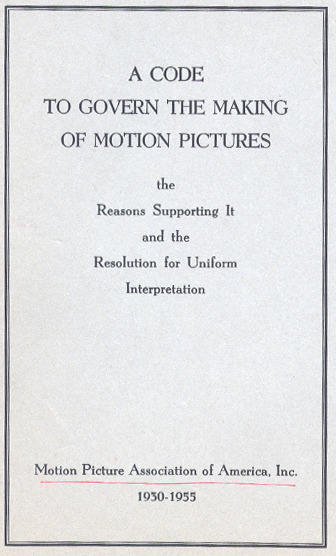


Under the leadership of Will Hays, the MPPDA, later the Motion Picture Association of America (MPAA) and the Motion Picture Association (MPA), adopted the Production Code #OnThisDay in 1930, but did not enforce it in earnest until 1934.
“No picture shall be produced which will lower the moral standards of those who see it.”
17 notes
·
View notes
Text
It is such a huge pet peeve of mine when people say that the Hays Code began in 1934. Will H. Hays was the first president of the MPPDA (now called the MPA) following its establishment in 1922, and throughout the 20s he began working to establish the future Motion Picture Production Code. The Code's precursor, known as the "Don'ts and Be Carefuls" lists, were released in 1927. This proto-Code went through multiple further revisions before being implemented in 1930.
There were a full four years where the Code was in place but not widely enforced. People think those four years basically didn't count, and that filmmakers had absolutely nothing to worry about, but that's just not accurate. Censorship was absolutely already happening, and the powers behind the Code were working all the while to give the Code the teeth it gained in 1934.
I personally feel that referring to 1930-1934 as the "pre-Code era" instead of something like "pre-Code-enforcement era" is misleading, and gets dangerously close to pretending that harsh censorship and fascism spring out of nowhere unannounced.
The Motion Picture Production Code, aka the Hays Code, didn't show up out of nowhere in 1934, damn it. Fascism does not show up unannounced, but it frequently gets ignored by people who want to pretend that things are perfectly fine right up until the last minute. Gah.
(For those interested in reading more, I recommend Pre-Code Hollywood: Sex, Immorality, and Insurrection in American Cinema; 1930-1934, by Thomas Doherty. That one has the full text of the Code included in the appendix, which is super useful.)
176 notes
·
View notes
Text
So picture this: Francis decides his guest bedroom at the country house looks "uninhabitable and vaguely fascist" and insists on a complete makeover. Henry, for god knows what reason (maybe boredom, maybe he lost a bet, maybe Francis guilted him with something like "you owe me for the pig's blood incident"), agrees to come with him to IKEA.
Francis, naturally, treats IKEA like a theatrical set. He's drifting through fake living rooms like he's auditioning for Les Mis, flopping dramatically onto sofas, muttering things like "This entire color palette is a hate crime" and "If I see one more fake fern I’m committing arson."
Henry is horrifyingly competent. He’s pushing the cart in eerie silence, reading product codes with military precision. He reads the Swedish names out loud and pronounces them flawlessly. Francis is unsettled. “Why do you know how to say ‘SKOGSTA’ with such confidence?”
Henry: “It means ‘forest.’”
Francis tries to sneak six packs of novelty cocktail straws into the cart. Henry removes them silently. This happens five times. It becomes a battle of wills. Francis eventually hides them inside a box of tealights. Henry later pays for the entire cart and leaves them in the IKEA parking lot with a subtle: "Happy now?"
When it comes time to assemble the furniture, they almost fistfight over the instructions. Francis insists on winging it. Henry, who has never not followed a manual in his life, physically rips the Allen wrench from Francis’s hand at one point.
At some point, the bookshelf collapses in slow motion and pins Francis’s arm to the ground. He moans, “Tell Richard I died with taste,” while Henry just sighs and lifts it off with one hand.
They finish at 3AM. Francis is wine-drunk and lying on the new rug like it’s a fainting couch. Henry sits on the arm of the newly-assembled loveseat, flipping through a Greek dictionary. Neither speaks for twenty minutes.
The room does, in fact, look stunning.
#the secret history#tsh#francis abernathy#henry winter#tsh donna tartt#winternathy#i'm back winternathy nation!#francis and henry fistfight UUMMMMhhhh#i'm normal about them
81 notes
·
View notes
Note
I'm having doubt because of the overall rejection towards byler, ppl that I know irl ship them or at least consider the possibility (without me saying anything) but ppl on the internet don't seem to? I'm surprised that queer people ship mileven, and they are totally allowed to ofc, but it surprises me a bit, is byler really that bad and forced or are ppl just haters?
My dear anon, the reason so many people don't think byler is gonna happen has nothing to do with the likelihood of byler, and everything to do with homophobia and heteronormativity.
This is actually a really great question for Pride Month, so here's some queer media history for you.
Queercoding and Heteronormativity
Let me introduce you to the Hays Code:
The Motion Picture Production Code was a set of industry guidelines for the self-censorship of content that was applied to most motion pictures released by major studios in the United States from 1934 to 1968. It is also popularly known as the Hays Code, after Will H. Hays, president of the Motion Picture Producers and Distributors of America (MPPDA) from 1922 to 1945.
Wikipedia
The code was made to regulate the moral content of films. It regulated films to showing only "correct standards of life" and not showing audiences that could tempt them to sympathize with "crime, wrongdoing, evil, or sin". The "crime, wrongdoing, evil, or sin" in question including abortion, ridiculing religion (read: christianity), nudity, premarital sex, a love triangle including married characters, interracial marriage, prostitution, and of course homosexuality.
While the code was technically voluntary, it was mandatory for any filmmaker who wanted their film to show in American theaters. For 30 years, almost every film produced in the US adhered to the Hays Code.
During this period of time we see the invention of queer coding. It was a way to acknowledge a characters LGBT identity, while still adhering to the code.
Some coding meant borrowing from some of the coding for straight sex (which was obviously also censored) like lighting each other cigarettes. Other hints a character could be queer could be that character wearing lavender colored clothing, handkerchiefs, or scented handkerchiefs. Calling a man a "confirmed bachelor" for example, was queer coding.
Anything more explicit then that had to give the character's "moral conflict" "the proper frame of reference". Meaning, If a character is more obviously gay they are punished for it. They're villains, and/or they die. They most certainly don't get to have a happy ending. This is where you get the bury your gays trope.
The code dissolved in 1968, instead becoming a rating system to warn audiences about a film's contents rather than outright blocking them. However, queer coding stayed.
There's a theory that I couldn't find a source for, but one that I remember from my Pop Culture class where I first learned about this stuff. It's called Inoculation Theory. The idea is that if you slowly introduce a top into pop culture and film, such as queer narratives, the general public will build a tolerance to it - like a vaccine. So queer coding slowly started to turn into queer storylines and queer storylines.
(A really great documentary to watch on this subject is called The Celluloid Closet, which discusses LGBT people in cinema and how that have evolved up until 1995 when the documentary was created.)
However, as a side effect of inoculating the public to queer narratives, they have grown tolerant of queer narratives in a different way... They have seen queer coding so much, they have grown less sensitive to it. They fail to see the signs of a queer narrative because it doesn't matter - that character will probably be killed off. They won't get a happy ending, and they certainly won't get to be in a relationship with another member of the cast.
Now... it's not that overt. I doubt a lot of people are thinking those exact things, but it's so ingrained in our collective society - people don't see queer storylines as ones that tend to get fully realized, or get happy endings, based on the media they've consumed.
Now this is all assuming the best of people, but there's a nefarious flip side to all of this:
Queerbaiting and Homophobia
Where queer coding is a way to get a queer narrative into the world without pissing off the censors, queer baiting is the opposite. Queer baiting involves the marketing of the show or movie alluding to LGBT representation without actually giving that representation - at least not in a meaningful way. They're trying to bring in a broader audience to watch their show or their movie without alienating their straight, homophobic, conservative audience members.
Famous examples of this include Sherlock, Supernatural, and Voltron.
Queer baiting is homophobic and cruel and common.
So with queer coding and queer baiting combined, the general audience doesn't see queer storylines as viable. Queer characters are expendable, and their stories aren't as important as they stories of straight characters.
Now, there is queer representation out their in the world, but it's less likely to happen, in the eyes of the conservative, heteronormative public, in a normal show or movie. A visual media that isn't explicitly "for the gays", like Heartstopper, Love, Simon, or Red, White, & Royal Blue. (Those shows and movies are great - but they're explicitly queer stories.)
The idea that a ship like Byler could show up in a wildly popular non-queer (to them) show, is frankly unheard of.
But more than just general skepticism and denial - we are in a period of conservatism and homophobia. People are just homophobic, and the idea that a gay character could "tear apart" a straight relationship... they're afraid of it.
And even more so because it's plausible.
You wanna know why people don't worry about Robin/Vickie - because it's not breaking up an established straight couple. Ronance? Steddie? Because it's not gonna happen. Let the gays have their "silly little romances" because they don't stand a chance of becoming canon. It's just fanfiction and headcanons.
But Byler is real, and it's threatening. That's why they hate it.
Hays Code sources: 1/2/3
27 notes
·
View notes
Text

Pre-Code refers to a time of relaxed censorship: The pre-Code era was a period from roughly 1929 to 1934 where the Motion Picture Production Code (also known as the Hays Code) was in place but not strictly enforced. This allowed filmmakers more freedom to explore controversial topics and include content that would later be restricted. American movies, for instance, were at their most raucous and racy, a time when illicit sex and violence were common themes.
#pre code#vintage hollywood#old hollywood#screen legend#movie star#1930s#actress#1920s#talkies#film makers#hays code
27 notes
·
View notes
Text

“THOU SHALL NOT”
This photo was created by Whitey Schafer in 1940 to protest the self-censorship imposed by The Motion Picture Production Code, better known as the Hays Code, by breaking ten of its precepts in one image.
( The woman looks a little like Cloris Leachman to me )
Thinkaboutit
33 notes
·
View notes
Text
Lallybroch: copyright vs. trademark
An excellent question was asked by our friend @rosfrank in the comments thread to 'The door faces North' post and given the cosmic amount of uninformed bullshit being ventilated for almost ten years in this fandom, I think it's time to answer it once and for all:
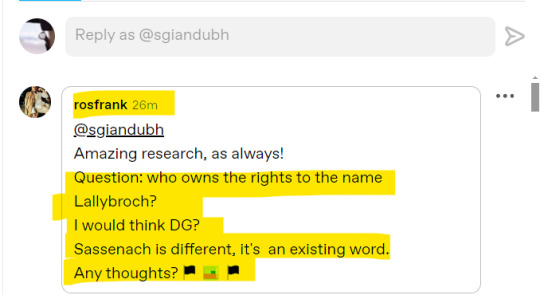
Whenever we are informally talking about 'owning the rights to something', I think it's very important to bear in mind a fundamental distinction between two different categories of ownership rights: copyright and trademark.
The copyright is the most familiar one to many of you. It is what you usually find on those annoying and apparently useless first or last pages of all the printed or digital editions on this planet. Something like this:

In the US, copyright issues are regulated by the Copyright Act of 1976, as included in Title 17 of the US Code. The US public authority competent for registering and managing copyright is, as predictable, the US Copyright Office.
Perhaps the most seminal US Supreme Court decision, as far as copyright is concerned, is the 1991 Feist Publications, Inc., v. Rural Telephone Service Co. In it, the Court ruled that mere compilations of information or facts (such as, for example, telephone books) are not protected by copyright, according to US law. In other words, the ancient legal concept of 'sweat of the brow' (which simply means the amount of work required to gather and compile those facts/information) is not enough to qualify a work for copyright protection, if no creative effort is added to enhance its content. This is why I have always considered absolutely ridiculous Marple's efforts to watermark public information screenshots: it is useless (to the extent that it legally protects her from nothing) and, as her timelines, a mere compilation of facts (legally ditto). A similar approach is preferred by the UK and also by many Roman law legal systems, such as the French one - just making things clearer, here, by the way.
See how 'Erself is roughly doing, right now, in this department:

But I am rambling. In my view, Lallybroch, as a pivotal concept used in Diana Gabaldon's books, is protected by the copyright granted to each and every of her books mentioning it, according to the Roman law principle 'accessorium sequitur principale' (the accessory follows the principal). So it will remain protected for at least 70 years since the last of her books mentioning it would have been published under copyright. Unless she chooses to separately protect the entire finished cycle as a whole, once Book Ten (fingers crossed) is published, preferably during our foreseeable lifetimes.
That being said, that goes only for one copyright category: (published) text - you cannot copyright that secret diary in your drawer, LOL. This is why, the current US Copyright Office records concerning Lallybroch look like this:
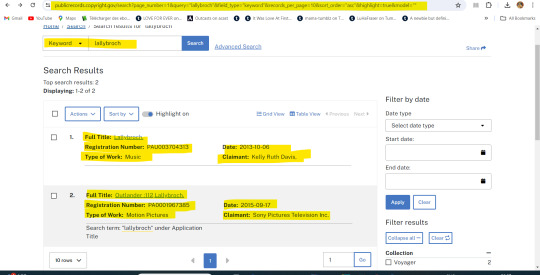
Sony Pictures Television Inc owns the copyright to the fictional name Lallybroch in the motion pictures category, as it is the title of the Episode 12, in Season 1 - DG has been handsomely compensated for this, no worries. And someone I have no idea about owns the rights to an original musical score she has written and titled Lallybroch in the music category, since October 2013.
Onwards to the trademark. This is something different and this is all about making your name/concept/idea profitable. It is all about branding it, putting it on a product and selling it under that brand. It includes all the graphic elements and the logo of the brand (accessorium...) - in short, its visual identity to the consumers. In the US, trademark issues are regulated by the 1946 Lanham Act and the public competent authority is the good old US Patent and Trade Office (USPTO).
Right now, the situation for the Lallybroch trademark is as follows:
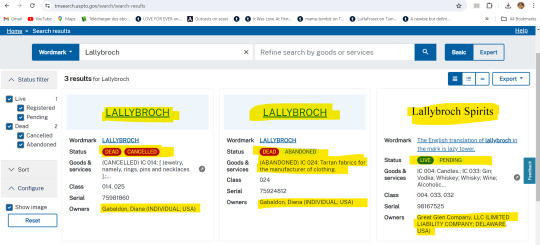
So, we see three different trademarks: two of them, owned by Diana Gabaldon, are classified as 'dead' (cancelled and/or abandoned) and the third, Lallybroch Spirits, owned by S's Great Glen Company is pending approval - he will not be able to label any booze bottle Lallybroch Drink Me before permission is granted by the USPTO.
Let's unpack:
Both Lallybroch trademarks formerly owned by Diana Gabaldon were filed at the USPTO on February 21, 2000 and granted on December 12, 2000. The first was aimed at producing 'tartan fabrics for the manufacturer of clothing' and it was abandoned in December 2003:

The reason is that the owner did not file in any Statement of Use after the trademark was granted. She had three years to do so, and since she chose not to do anything about it, the trademark was deemed abandoned (Stacy K. Smith is the attorney hired by Herself, btw). That means she specifically implied not to intend using it in the future. As such, she may claim NO rights on a now free to use mark:
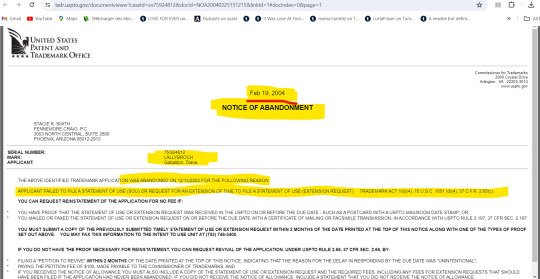
The second trademark was aimed at producing 'clothing, namely, t-shirts, dresses and headwear' and also 'jewelry, namely, rings, pins and necklaces'- to cut the story short: OL merchandise - and it was cancelled on March 1st, 2013:
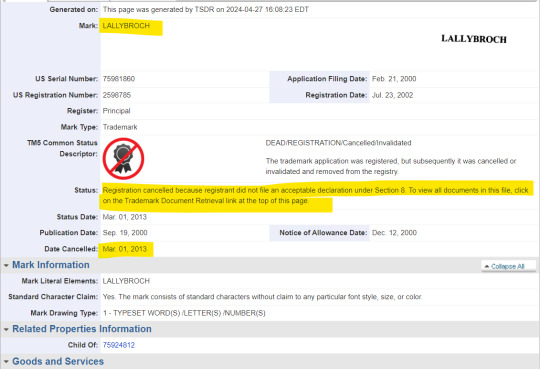
The reason is that the owner did not file the Section 8 declaration (of continuous use for five years) within the allowed legal timeframe (6 months after the fifth anniversary of the trademark granting renewal). Her trademark federal rights are now deemed canceled (but not her state law and/or common law rights!) and if she wants to ever use that name again, she would have to start the whole process over, bearing in mind the trademark could have been granted to someone else, in the meanwhile (not her case).
And for anyone who might ask, 'Erself does not own any other trademarks whatsoever:

The other (Doll Lab - LOL for ages) Diana Gabaldon is a pharmacist from Albuquerque, NM. Chill. 🤣🤣🤣
The owner of the copyright to the fictional toponym Lallybroch, as far as published text is concerned, is Diana Galabdon.
The owner of the copyright to the fictional toponym Lallybroch, as far as motion pictures are concerned, is Sony Pictures Television Inc.
The owner of the copyright to the fictional toponym Lallybroch, as a personal work of music, is Mrs. Kelly Ruth Davis, of Pennsylvania, USA.
The owner of the Lallybroch Spirits trademark will be Sam Roland Heughan, when that trademark is granted by the USPTO.
I hope this answers your question, @rosfrank. Thank you for asking.
111 notes
·
View notes
Text
Giving Them the Moment: How Our Flag Means Death and it's Portrayal of Black Men is the Most Important Thing on Television Right Now
Note: written April 20, 2022
Media is an incredibly distinct way of communicating. It has a wide reach, and each person has their own interpretation of what they see. That’s the beauty of the medium as a whole. However, there are often downsides, especially when it pertains to the West. In the US in particular, there is a trend within popular media to lean towards propagandization. Whether it’s the idea that communism and socialism are products of the ‘Evil East’ or the lingering effects of the Motion Picture Production Code - also known as the Hays Code, the media monopolies have a firm grasp on what we as a society watch and enjoy.
When you begin to play close attention to how the media portrays Black men, this becomes abundantly clear.
It is a rare thing when we see Black men whose characters aren’t portrayed as being the object nor the perpetrators of violence. In fact, only one mainstream popular show comes to mind: The Fresh Prince of Bel Air. But even then, the given circumstances of Fresh Prince revolve around Will’s escape from the violence of the ‘urban’ inner city. This vilification of Black men dates back to the 1910s with D. W. Griffith’s Birth of a Nation, and continued into the 1930s, where Black people were often personified as the monsters, representing the ‘exciticism’ of the world beyond the West. It is the ‘exoticism’ that has played a huge part in the dehumanization of Black men as a whole. But as a Black Queer person watching Our Flag Means Death, it is breaking that mold in an incredibly important way.
The Black men in the show are allowed to have fun.
This show is breaking barriers left and right. Of the major recurring cast of 15, over half of them are people of color. It’s overt and unflinching portrayal of Queerness when so many of its older viewers - myself included - have lived through the Bury Your Gays and Dead Lesbians tropes time and time again is overwhelmingly refreshing. Nearly all characters are Queer until proven straight and represent all parts under the umbrella, including Leslie Jones’ polyamorous pirate queen and Vico Ortiz - a non-binary actor - playing a non-binary character.
But in a world where the narratives of Black men are so often framed around violence and brutality, the Black crewmates of the Queen Anne’s Revenge - Frenchie, Oluwande, and Roach - are allowed to be funny and vulnerable. Each one of them is starkly different from the other with identifiable characteristics that allow the audience to humanize them. The trio quickly became my favorites among the crew, with Roach being the stand-out amongst them. Samba Schutte’s often deadpan delivery never fails to draw a laugh from me, in particular the assertion that “meat is meat”. Frenchie, played by Joel Fry, is the quickest on the draw where his intellect is concerned, being posited in the show’s fifth episode as having had a hand in inventing the pyramid scheme while spouting the wildest of conspiracy theories and being afraid of cats (they’re witches, they steal your breath, and have knives in their feet, you know). The softness and constant vulnerability of Samson Kayo’s Oluwande may be one of the most important aspects of the show, as it establishes him as a reliable and trustworthy confidante to not just Jim, but to Rhys Darby’s Stede Bonnet as well.
They exist in their own separate spheres on the ship, going about their own separate business completely unbothered. While it is implied they lead violent lives as pirates, this violence isn’t used to define them as characters. In fact, Oluwande stated that both he and Jim engaged in piracy because they “had no choice”. The brief mention we get of Frenchie’s backstory implies that he lives a life of servitude, though whether that was as an enslaved person or a freed Black domestic worker is not mentioned. While there is little known about Roach so far, it is implied that his culinary skills are far beyond the levels of what is needed aboard a pirate ship.
The friendships and relationships they form within the crew aren’t built on violence either, but on open and honest communication. Most notably, the friendship of Frenchie and Wee John Feeny, played by Kristian Nairn. Fry and Nairn are an impeccable comic duo when their characters become ‘room people’, and the scene where they begin to design their new space is a personal highlight of the episode. Oluwande and Jim’s romance - played to perfection by Kayo and Ortiz - is one that revolves around both characters being almost devastatingly open with each other. Both actors play the emotional vulnerability of the characters well, and it is important to emphasize that it is Kayo’s Oluwande that moves to meet Jim where they are.
While the show allows all its men to show varying levels of emotional vulnerability - an exception being offered to the emotionally constipated Izzy Hands, played by Con O’Neill - there is something so special about seeing that luxury afforded to Black men. This show has, in just ten episodes, has become a game changer for the television industry. It has proved that a show with explicitly Queer characters can become a massive sleeper hit, and that sometimes the best kind of historical show is one that is historical fiction. But it has also proved that you can create a narrative with Black men that doesn’t include their stories being framed in violence or brutality, that they can be funny, charming, witty, vulnerable, intelligent, complex characters with their own narratives that serve a purpose outside of a device of exoticism. It is this rare thing that makes these characters, and indeed the show as a whole, so important to its viewers.
We deserve more vulnerability, more humor, and more humanizing content from these three men, and this show is one that is truly deserving of a glorious second season.
Sources:
Donaldson, Leigh. “When the media misrepresents Black men, the effects are felt in the real world.”
https://www.theguardian.com/commentisfree/2015/aug/12/media-misrepresents-black-men-effects-felt-real-world.
Kumah-Abiwu, Felix. “Media Gatekeeping and Portrayal of Black Men in America.”
Opportunity Agenda. “Media Portrayals and Black Male Outcomes.”
https://www.opportunityagenda.org/explore/resources-publications/media-representation-impact-black-men/media-portrayals.
Our Flag Means Death, (2022-). HBO Max.
#not horror but its relevant#our flag means death#ofmd#ofmd s2#roach#frenchie#oluwande boodhari#david jenkins#black men in media#let black men be silly in things!!!!!!#our flag means death season 2
378 notes
·
View notes
Text
Events Leading to Stonewall
In honor of the Stonewall riots' anniversary I'd like to take a minute to talk about what led up to them.
The Stonewall riots, taking place June 28th, 1969, were a series of riots that started at the Stonewall Inn between police and LGBTQ+ protestors. The events leading up to them are just as important as their impact on today so a few of these events will be discussed in this post. Obviously I cannot cover them all but I plan on talking about more in their own posts.
After WW2 many Americans began efforts to restore the country to it's pre-war state and prevent change from occurring in the social order. During this time any groups considered "um-american" were deemed security risks, among these groups were gay men and lesbians. The reasoning behind this was that, according to the US State Department, they were deemed susceptible to blackmail. According to a report chaired by Clyde R. Hoey: "It is generally believed that those who engage in overt acts of perversion lack the emotional stability of normal persons" These actions led to 1,700 federal job applications being denied, 4,380 people being discharged from the military, and 420 individuals being fired from federal jobs, all due to suspicions of homosexuality.
In 1952 homosexuality was listed in the DSM as a mental disorder by the American Psychiatric Association. The reasoning behind this choice was a belief that homosexuality stems from an unreasonable fear of the opposite sex. Despite numerous studies contradicting this belief, including those of Evelyn Hooker, the APA did not remove homosexuality from the DSM until 1974. The lasting damage of this decision can be seen even today with many queer people still being seen as mentally ill for their identity.
The Hays code was originally implemented in 1934, also being known as the Motion Picture Production Code. Created by a Catholic man named Martin Quigley in 1929 the purpose of the Hays code was to enforce "morals" in the film industry in order to not badly influence american citizens, particularly children. Some examples of Inclusions prohibited by the Hays code include: Profanity, ridicule of the clergy and seuxla perversion (including homosexuality). The frustration regarding these rules could be felt at the time within the queer community and even today with tropes like queer-coded villains.
I hope this post helped to provide some context surrounding the events that kickstarted the Stonewall riots. Looking back at these events gives us both context for how far we've come aswell as how far we still need to go.
#queer history#historian#history#history facts#queer#lgbtq#lgbt#lgbtqia#lgbtq community#pride#pride month#stonewall#stonewall inn#stonewall riots#stonewall anniversary
48 notes
·
View notes
Text

Released on this day (5 October 1934) 90 years ago: Cleopatra, visionary director Cecil B DeMille’s lushly opulent and risqué account of the life and loves of Cleopatra VII. DeMille tells his story in 105-minutes – a model of concision compared to the to the bloated 1963 version starring Liz’n’Dick, which is a ponderous, mind-numbing four hours and twenty minutes long! The 1934 interpretation also offers the most sumptuous Art Deco of screen Cleopatras. (Which makes sense, because the Art Deco aesthetic was at least partially inspired by ancient Egyptian imagery). The Motion Picture Production Code came into effect during production, so the eroticism DeMille - the undisputed maestro of kinky pagan spectacle - was able to sneak past the censors is impressive. (We see exposed female nipples in the opening credits!). Claudette Colbert makes for a coolly calculating and seductive Cleopatra. Her slinky and revealing ensembles (heavy on gold lamé and exposed flesh) are by costumier Travis Banton, the genius who also dressed Paramount’s other divas like Marlene Dietrich and Mae West. His creations all seem to focus attention on Colbert’s boobs, and weirdly anticipate the wild looks Bob Mackie would create for Cher in the seventies. Bear in mind the durable Colbert made It Happened One Night, Imitation of Life and Cleopatra all in the same year – an amazing accomplishment for any actress. As Marc Antony, rugged British leading man Henry Wilcoxon matches Colbert for pulchritude and sex appeal (those togas sure showcase his muscled thighs). The sequence where Cleopatra initiates Marc Antony into Egyptian-style hedonism on her gilded barge - incorporating legions of homoerotic baby-oiled gladiators, slave boys in loincloths and semi-naked female concubines waving peacock feathers - is a fever dream of orgiastic Golden Age Hollywood depravity!
#cleopatra#cecil b. demille#claudette colbert#pre code hollywood#pre code movies#pre code film#queen of the nile#lobotomy room#classic hollywood#old hollywood#golden age hollywood#decadence#hedonism#depravity#paganism#ancient egypt#kitsch#camp#travis banton
22 notes
·
View notes
Text

Banned for indecency by the Motion Picture Production Code., it’s Joan Blondell in a 1932 promotional portrait for Warner Bros.

273 notes
·
View notes
Text
Random pet peeve:
It's not called the "Hayes Code." That's a misspelling. It's the "Hays Code." It was officially known as the "Motion Picture Production Code," and nicknamed the "Hays Code" after Will Hays, the first chairman of the MPPDA (know called the MPA). It was also infrequently referred to as the "Breen Code," after head censor Joseph Breen.
It doesn't actually matter that much. "Hayes" isn't such a bad misspelling that it keeps me from understanding what people mean, and the "Hayes" misspelling has been around since the Code's creation. Plus, unsolicited correcting of people's spelling and grammar gets obnoxious (and frequently bigoted) real fast. But I see that misspelling so often in materials that are ostensibly trying to educate, so I feel compelled to say that, if you're genuinely trying to learn more about the topic (or educate people on the topic), make sure you know the proper spelling so you can find the info you need! Running searches for misspelled keywords means you'll miss things. And the Hays Code is important to know about if you're concerned about rising waves of American media censorship.
107 notes
·
View notes
Text
Queerwolf By Night: Queercoding, Media Literacy, and Werewolf By Night
Okay, @bluemoonperegrine got me thinking about a thing, so it's time for Media Studies And Writing Hacks With Kat. Grab your beverage of choice, and let's talk about queercoding in Werewolf By Night.
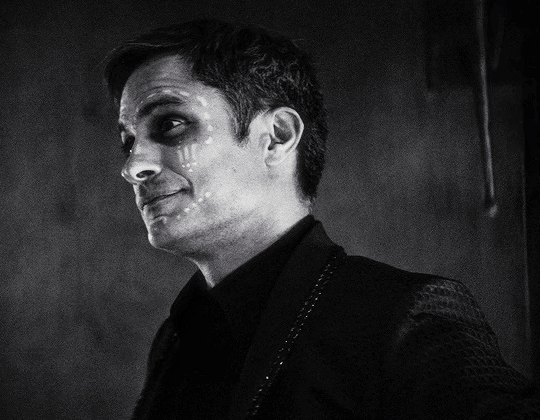
Let's start with a definition, because queercoding can sound like a conspiracy theory if you don't understand the context. In media studies, "coding" means using indirect means (usually details) to imply a state of being without explicitly stating that such a state exists. For example, if you're watching a TV show about a group of high-school friends, and one of the characters is consistently dressed in more expensive-looking clothes than the others, is more familiar with elite cultural signifiers like designer brands, and casually drops statements like, "Oh, yeah, I met him in the Hamptons last summer," then that character is being coded as wealthier than the others. Now, if a knowledgeable character SAYS, "Oh, that's Amelia, her family's rich," then it's not coding anymore. Amelia isn't wealthy-coded; she's just wealthy. Coding is only coding if the state of being is IMPLIED.
Now, why would anyone use coding when explicit statements are an option? Why can't people just say Amelia is rich? There are a number of reasons. First, maybe there isn't time or space to establish every single detail of a character through dialogue. Maybe Amelia's wealth is important to the story, but less important than the fact that she's dying of cancer, or in unrequited love with another character, or obsessed with rubber ducks. Or, second, maybe the coding is a setup for some kind of surprise or reversal. Maybe Amelia wears fancy clothes and has summered in the Hamptons, but surprise! Her parents just went to federal prison for fraud, and she's now penniless and sleeping on another character's couch, with no one mentioning it at first because it's painful for her.
And finally, there's arguably the most famous reason for using coding in media: because you literally can't be explicit about it. Let's talk about the Hays code.
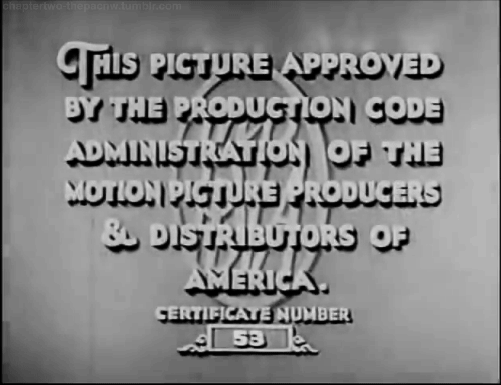
The Motion Picture Production Code, widely known as the Hays code, was a set of mostly self-imposed rules restricting the content of Hollywood movies between the 1930s and the 1960s. There was effectively a censorship board in charge of approving, disapproving, and demanding changes to films. The Code arose in response to a moral panic about sex and violence in movies; studios instituted the censorship board as a preemptive measure to head off possible censorship legislation. At the time, movies were such a new art form that there were serious concerns that First Amendment free-speech protections might not apply to them, so studios came up with this self-censorship system to avoid dealing with external censorship.
And what guidelines did they choose, you may ask?
Essentially, the guidelines were the conservative Catholic values of the 1930s. Yes, Catholic specifically; the man in charge was Catholic and talked a lot about how he applied his personal values to the task. So the Code included rules like a ban on insulting or denigrating religion or its institutions, among other things. There were also restrictions on what kind of crime and violence could be displayed, sex rules so strict that even married couples couldn't be shown in the same bed (if they even sat on a bed together, they had to keep at least one foot on the floor), and you KNOW there was a ban on anything gay. It was called "perversion" in the text of the code, but it meant gay stuff. Or trans stuff. Or kink. Or women being interested in sex. You get the idea.
But there was an exception to all these rules, and it was that more "objectionable" traits were allowed for villains. After all, a film isn't endorsing murder if the murderer goes to jail at the end and everyone stands around saying, "Wow, murder sure is terrible!" Right?
Yeah, what happened in practice was that filmmakers started giving villains and monsters traits that were stereotypically associated with queerness, supposedly to heighten how eeeeeevil these characters were, but actually for any number of other reasons. Apropos of absolutely nothing, here's Peter Lorre being extremely heterosexual with a cane in The Maltese Falcon.
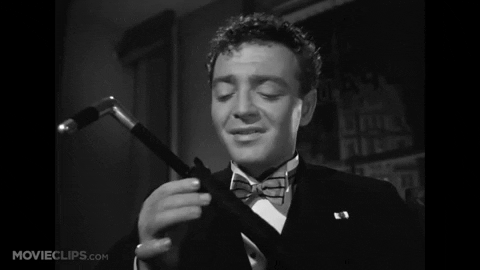
Now, how does this relate to WBN? Well, we all know WBN is an explicit love letter to 1930s and 1940s horror movies. If you don't believe me, here's Lon Chaney Jr. in 1940:
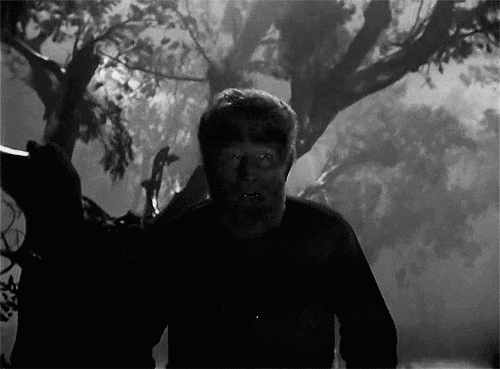
And here's Gael Garcia Bernal in 2022:
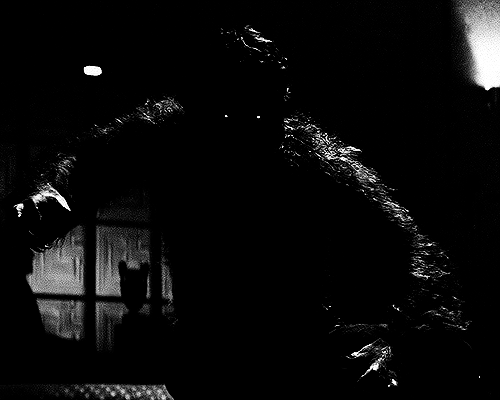
So let's talk about queercoding in classic Hollywood horror movies.
Obviously, confining queer material to villainous characters meant that monsters and their movies could be MUCH queerer than the rest of Hollywood's output. It also helped that horror filmmaking was full of extremely queer artists like James Whale, the openly gay director of Frankenstein. He's often brought up as an example of really obvious queercoding in horror cinema, especially in regard to his film Bride of Frankenstein, in which a young scientist is literally lured away from his impending marriage to a woman in order to create life with a VERY queercoded older man.
Look at these proud new dads.
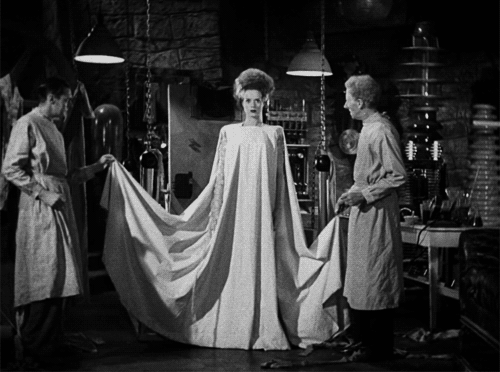
And lest you think this is an outlier, let me introduce you to Dracula's Daughter, aka the Carmilla adaptation with no lesbian overtones, no sirree:

Yeah, queercoding is absolutely A Thing in classic Hollywood horror. It's part of why horror movies are as much of A Thing in gay culture as they are.
The Hays Code went away in the 1960s, partly due to the fact that Code compliance was SUPPOSED to be the one true path to wide distribution and profit, and yet the genderbending comedy Some Like It Hot made piles of money despite not being even CLOSE to Code-approved.
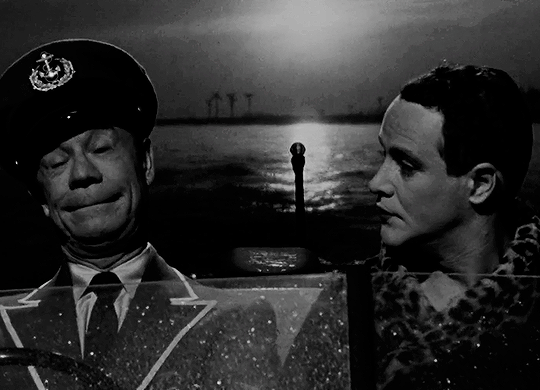
But 30 years is long enough to develop an entire cinematic language, and the legacy of the Hays Code lives on in things like queercoded Disney villains.
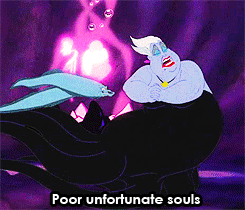
Now, let's talk about Werewolf By Night. A movie made under conditions not dissimilar to those of the Hays code in that Disney, for all its vaunting of First Gay Characters, absolutely refuses to put those characters in anything with wide distribution in such a way that they can't be edited out for Singapore.
So if your choices are 1) No Gay Stuff, 2) Easily Deleted Gay Stuff, and 3) Gobs and Gobs of Queercoding That Can't Be Removed, and you're making a retro black-and-white horror movie, you may find that option three makes the best, and queerest, movie. The cinematic language is all there for you, and you know at least some of your audience will pick up what you're putting down. And at this point, it's practically a genre expectation.
Now, I want to be clear about something: coding of any kind is, by its very nature, subject to interpretation. If we say something is queercoded, we are NOT saying that it's explicitly queer or that no heterosexual explanation exists or whatever. That's not how coding works. Queer theory and queercoding are a lens through which to look at a work. Sometimes queercoding is even unintentional; it's baked into so much American media by now that tropes like queer-coded villains sometimes happen not for particularly queer reasons but because an actor decided he wanted to sound like the villain in his favorite black-and-white movie. When I say WBN has queercoding, that is ALL I'm saying--that the coding is there. (And yes, I do realize this is the piss-on-the-poor website. Sigh.)
Queercoding is also not queerbaiting; the latter is where a piece of media deliberately builds up the expectation of expressly queer content and then refuses to deliver, often while mocking queer fans who fell for it. (Looking at you, Sherlock and Supernatural.) Queercoding may be used for queerbaiting, but the terms are not synonymous. Because WBN makes no queer promises (no romantic promises at all, really), it cannot be said to be queerbaiting.
So with all that in mind, let's look at coding in Werewolf By Night. And because he's the protagonist and everyone's favorite woobie, we'll start with Jack.
Look at this man. Enjoy him.
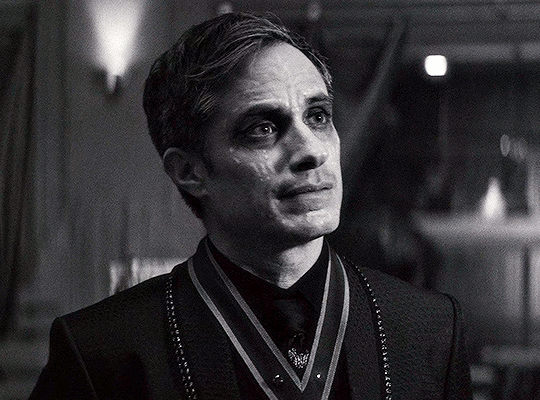
He will be the subject of Part Two.
#werewolf by night#queer theory#queer studies#werewolf by night meta#hays code#film history#long post#media studies and writing hacks with kat
50 notes
·
View notes
Text
Doctor X is a 1932 American pre-Code mystery horror film produced jointly by First National and Warner Bros. Based on the 1931 play originally titled The Terror by Howard W. Comstock and Allen C. Miller,[2] it was directed by Michael Curtiz and stars Lionel Atwill, Fay Wray and Lee Tracy.
Doctor X was produced before the Motion Picture Production Code was enforced. Themes such as murder, rape, cannibalism and prostitution are interwoven into the story. The film was one of the last produced, along with Warner Bros.' subsequent Mystery of the Wax Museum (1933), in the early two-color Technicolor process. Separate black-and-white prints were shipped to small towns and foreign markets, while color prints were reserved for major cities.[3]
In the film, there are a series of murders in New York City. Each murder takes place under the full moon, and each body has been cannibalized post-mortem. Dr. Xavier is asked to provide his medical insight into the crimes, though the police actually suspect him and other people in Xavier's medical academy. The Moon Killer is conducting his own experiments, in an attempt to collect samples from his victims.
video from trade movie podcast
#tiktok#trade movie podcast#doctor x#1930s#20th century#pre code hollywood#horror#movies#film#film review#two color technicolor#technicolor#blu ray
9 notes
·
View notes